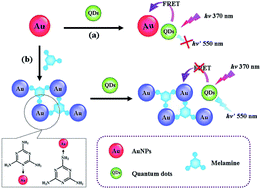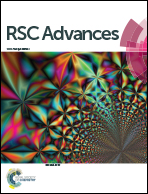Label-free fluorescence turn-on sensing for melamine based on fluorescence resonance energy transfer between CdTe/CdS quantum dots and gold nanoparticles
Abstract
A label-free fluorescence turn-on sensing system based on fluorescence resonance energy transfer (FRET) between CdTe/CdS quantum dots (QDs) and gold nanoparticles (AuNPs) is developed for the detection of melamine. This FRET process originated from a fluorescent donor–acceptor pair, in which CdTe/CdS quantum dots act as donors and AuNPs as acceptors, owing to the overlap of the fluorescence spectrum of the quantum dots and absorption spectrum of the AuNPs, leading to a decrease in the fluorescence signal. However, the presence of melamine resulted in the aggregation of AuNPs via multiple combinations between melamine and AuNPs, which reduced the spectral overlap and hampered the FRET process by restoring the fluorescence signal. The fluorescence enhancement exhibits a linear relationship to the melamine concentration from 5.0 × 10−8 M to 1.0 × 10−6 M with a detection limit of 3.0 × 10−8 M. Good detection of melamine in raw milk and milk products was also achieved. This sensing system is facile, rapid, easy to implement and may provide a new avenue for the determination of melamine in real samples.


 Please wait while we load your content...
Please wait while we load your content...